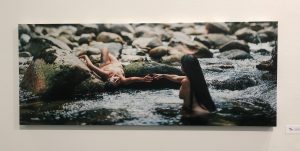By: Ben McGuinness, Peak Associate
qaʔ yəxw – water honours us: womxn and waterways is a mixed-media exhibition by a collective of local Indigenous women artists at the Bill Reid Gallery. The exhibition, curated and created by the ReMatriate Collective, blends themes of matriarchy and water, resurrecting the traditional power of Indigenous women amid their intersectional oppression in the colonial settler-state of Canada.
The Bill Reid Gallery, named after and featuring the work of late Haida artist, is an easy-to-miss cultural jewel tucked away behind a cathedral and lush green courtyard just off of Hornby Street. If you go early on a weekday as I did, it is usually very quiet.
Though as thoroughly modern as any Vancouver fixture, the two-story Bill Reid Gallery is subtly shaped like a traditional big house: a large open area with an arched ceiling, a surrounding balcony forming the second floor; wooden stumps for seats, trunks for display stands, and a totem pole watching over all. No matter what’s on display, the Gallery’s collection of excellent Haida carvings, jewelry, and prints are always on show.
Upon entering, I found myself revisiting Bill Reid’s materials and struggling to locate the qaʔ yəxw exhibit. The program informed me that this was intentional. The exhibit was placed to flow organically with the usual offerings, and the inclusion of a carving, Reflections by Veronica Rose Waechter (Gitxsan), and beadwork was intended to blend the women’s work on display into the, typically male-dominated, world of public carvings and mixed-medium Indigenous artwork.
You know you have landed on the exhibit, however, when you come across the photography pieces. The works of ReMatriate Collective adopt branded iconography to take scenes of First Nations women at work in the water and form a statement about celebrating and giving power to these taken-for-granted labours. We Are Enough and The Space In Between by Lindsay Delaronde (Mohawk) and Dionne Paul (Nuxalk/Sechelt)feature two Indigenous women in intimate moments of energy and knowledge transference. The multi-part works in St’langng Laanaas Clan by Kali Spitzer (Kaska Dena) are strong yet vulnerable portraits of artist Audrey Siegl (Musqueam), creating space to remember her sister Maria Siegl and the many other Indigenous women lost to different violences in the province.

These photography pieces stand out from the permanent collection at Bill Reid, yet the damp, muted, and unmistakably West Coast green colours, along with the deep darks that capture the nooks and crannies of the subjects’ skin, somehow make these pieces perfectly at home next to Reid’s works.
The themes of matriarchy and life-giving water are present all through the exhibit, and the distinction between these two themes is intentionally fluid. For local First Nations like Tsawwassen, water is a major feature of the land and of livelihood, but the exhibit also aims to reclaim its connection to the women who are made of water, live from the water, and are fundamental to life like water. In these pieces, water represents a reconnection to the land and summoning the power of ancestors to overcome today’s oppressions against Indigenous women.
The qaʔ yəxw exhibit is fairly small, so it may be worthwhile to combine your visit with the next upcoming feature at Bill Reid. SFU students are admitted for free, so the space is well worth being acquainted with. I encourage you to make time for this celebration and showcase of local Indigenous women and sacred connections to water — you will not leave disappointed.
qaʔ yəxw – water honours us: womxn and waterways will be featured at the Bill Reid Gallery until October 2, 2019. SFU students and Indigenous peoples enter for free.





[…] August, in addition to its permanent collection, the Bill Reid Gallery has two special exhibitions: qaʔ yəxʷ – water honours us: womxn and waterways and Language Matters. Open for all of August and free […]